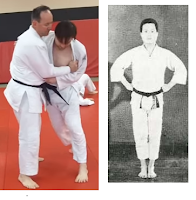One common application for the mountain block / W-block, first found in Toi-Gye, is an outside-trip throw performed by sliding down the opponent's leg with the "stomp" motion. This is closest to what is called an o soto otoshi in Judo. In Toi-Gye the first W-block follows the "hands-on-waist" position, which may be used to pull in an opponent before the throw.
 |
| Source: Freestyle Judo |
This throw is a common application for the W-block, and I use it for two other patterns (Sam-Il and Gae-Baek). However, there are a couple other ways to interpret these two movements from Toi-Gye. I will share one below.
Alternative: Thrown then Stomp
An alternative interpretation of these two movements is that the hands-on-waist position is the throw, and the first mountain block is a stomp of your downed opponent.
We use this application following the opening movement of Toi-Gye as a strike to the opponent's neck.
Having momentarily stunned our opponent, we put them into a headlock while pulling their arm, also called a chancellery. We turn 180-degrees CCW so that we are facing left, like in the form. From here we can perform a cross-buttocks or hip-wheel throw.
 |
| Source: Andy Allen demonstrating a cross-buttocks throw from Heian Sandan. Source Video |
After this throw, you may stomp your downed opponent before disengaging. One example of this, a humerus stomp, is shown by Tom Hill in the gif below:
 |
| Humerus stomp after a cross buttocks throw. Source: Tom Hill's Karate Dojo |
The arms of the W-block aren't doing anything in this case, except perhaps providing momentum for the stomp.
Alternative 2: Reverse headlock followed by knee strike
Yet another interpretation of the hands-on-waist position is a reverse headlock while pulling the opponent's right arm.
 |
| Right image source: Kata for Self Defense Shotoryu Goshinjutsu |
You may be able to execute this after the reverse punch in the previous step.
From here, it's easy to see how you can use the leg lift for the W-block as a knee strike to the back of the oppoonent, perhaps followed by the W-block as a downward elbow strike or as an attack to the opponent's elbow.
There you go: three applications for the first mountain block in Toi-Gye. Is there one you prefer, or something else?



No comments:
Post a Comment